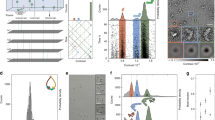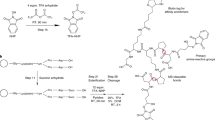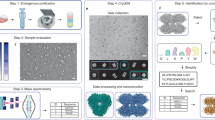Abstract
Systems biology conceptualizes biological systems as dynamic networks of interacting elements, whereby functionally important properties are thought to emerge from the structure of such networks. Owing to the ubiquitous role of complexes of interacting proteins in biological systems, their subunit composition and temporal and spatial arrangement within the cell are of particular interest. 'Visual proteomics' attempts to localize individual macromolecular complexes inside of intact cells by template matching reference structures into cryo-electron tomograms. Here we combined quantitative mass spectrometry and cryo-electron tomography to detect, count and localize specific protein complexes in the cytoplasm of the human pathogen Leptospira interrogans. We describe a scoring function for visual proteomics and assess its performance and accuracy under realistic conditions. We discuss current and general limitations of the approach, as well as expected improvements in the future.
This is a preview of subscription content, access via your institution
Access options
Subscribe to this journal
Receive 12 print issues and online access
$259.00 per year
only $21.58 per issue
Buy this article
- Purchase on Springer Link
- Instant access to full article PDF
Prices may be subject to local taxes which are calculated during checkout




Similar content being viewed by others
References
Aebersold, R. & Mann, M. Mass spectrometry-based proteomics. Nature 422, 198–207 (2003).
Lucic, V., Forster, F. & Baumeister, W. Structural studies by electron tomography: from cells to molecules. Annu. Rev. Biochem. 74, 833–865 (2005).
Best, C., Nickell, S. & Baumeister, W. Localization of protein complexes by pattern recognition. Methods Cell Biol. 79, 615–638 (2007).
Nickell, S., Kofler, C., Leis, A.P. & Baumeister, W. A visual approach to proteomics. Nat. Rev. Mol. Cell Biol. 7, 225–230 (2006).
Frangakis, A.S. et al. Identification of macromolecular complexes in cryoelectron tomograms of phantom cells. Proc. Natl. Acad. Sci. USA 99, 14153–14158 (2002).
Ortiz, J.O., Forster, F., Kurner, J., Linaroudis, A.A. & Baumeister, W. Mapping 70S ribosomes in intact cells by cryoelectron tomography and pattern recognition. J. Struct. Biol. 156, 334–341 (2006).
Malmström, J. et al. Proteome-wide cellular protein concentrations of the human pathogen Leptospira interrogans. Nature 460, 762–765 (2009).
Schmidt, A. et al. An integrated, directed mass spectrometric approach for in-depth characterization of complex peptide mixtures. Mol. Cell. Proteomics 7, 2138–2150 (2008).
Nally, J.E., Artiushin, S. & Timoney, J.F. Molecular characterization of thermoinduced immunogenic proteins Q1p42 and Hsp15 of Leptospira interrogans. Infect. Immun. 69, 7616–7624 (2001).
Kennaway, C.K. et al. Dodecameric structure of the small heat shock protein Acr1 from Mycobacterium tuberculosis. J. Biol. Chem. 280, 33419–33425 (2005).
Kim, R., Kim, K.K., Yokota, H. & Kim, S.H. Small heat shock protein of Methanococcus jannaschii, a hyperthermophile. Proc. Natl. Acad. Sci. USA 95, 9129–9133 (1998).
Keller, A., Nesvizhskii, A.I., Kolker, E. & Aebersold, R. Empirical statistical model to estimate the accuracy of peptide identifications made by MS/MS and database search. Anal. Chem. 74, 5383–5392 (2002).
Stahl-Zeng, J. et al. High sensitivity detection of plasma proteins by multiple reaction monitoring of N-glycosites. Mol. Cell. Proteomics 6, 1809–1817 (2007).
Forster, F., Pruggnaller, S., Seybert, A. & Frangakis, A.S. Classification of cryo-electron sub-tomograms using constrained correlation. J. Struct. Biol. 161, 276–286 (2008).
Baxter, W.T., Grassucci, R.A., Gao, H. & Frank, J. Determination of signal-to-noise ratios and spectral SNRs in cryo-EM low-dose imaging of molecules. J. Struct. Biol. 166, 126–132 (2009).
Gao, H. et al. Study of the structural dynamics of the E. coli 70S ribosome using real-space refinement. Cell 113, 789–801 (2003).
Brandt, F. et al. The native 3D organization of bacterial polysomes. Cell 136, 261–271 (2009).
Ghaemmaghami, S. et al. Global analysis of protein expression in yeast. Nature 425, 737–741 (2003).
Dresios, J., Derkatch, I.L., Liebman, S.W. & Synetos, D. Yeast ribosomal protein L24 affects the kinetics of protein synthesis and ribosomal protein L39 improves translational accuracy, while mutants lacking both remain viable. Biochemistry 39, 7236–7244 (2000).
Förster, F., Medalia, O., Zauberman, N., Baumeister, W. & Fass, D. Retrovirus envelope protein complex structure in situ studied by cryo-electron tomography. Proc. Natl. Acad. Sci. USA 102, 4729–4734 (2005).
Acknowledgements
This project has been funded in part by ETH Zurich, the Swiss National Science Foundation (grant 31000-10767), federal funds from the US National Heart, Lung, and Blood Institute, the US National Institutes of Health (contract N01-HV-28179), by SystemsX.ch the Swiss initiative for systems biology, in part by the proteomics in time and space (PROSPECTS) European network of excellence, and with funds from the European Research Council project 'Proteomics V3.0'. M.B. was supported by a long-term fellowship of the European Molecular Biology Organization and a Marie Curie fellowship of the European Commission; J.A.M. was supported by a fellowship from the Swedish society for medical research (SSMF); and A.S. and V.L. were supported by the Competence Center for Systems Physiology and Metabolic Diseases. We thank O. Medalia, W. Baumeister, members of the electron microscopy facility of ETH Zurich (EMEZ) for continued support and F. Förster for critical reading of the manuscript.
Author information
Authors and Affiliations
Contributions
J.A.M. and M.B. planned the experiments, performed the experimental work and data analysis and wrote the manuscript. A.S. and V.L. participated in the experimental work and the data analysis. E.W.D. assembled the PeptideAtlas build. R.A. was the project leader and wrote the manuscript.
Corresponding author
Supplementary information
Supplementary Text and Figures
Supplementary Figures 1–7, Supplementary Tables 1–3 and Supplementary Results (PDF 3539 kb)
Rights and permissions
About this article
Cite this article
Beck, M., Malmström, J., Lange, V. et al. Visual proteomics of the human pathogen Leptospira interrogans. Nat Methods 6, 817–823 (2009). https://doi.org/10.1038/nmeth.1390
Received:
Accepted:
Published:
Issue Date:
DOI: https://doi.org/10.1038/nmeth.1390
This article is cited by
-
Isotropic reconstruction for electron tomography with deep learning
Nature Communications (2022)
-
Elusive data underlying debate at the prokaryote-eukaryote divide
Biology Direct (2018)
-
Improved deep learning-based macromolecules structure classification from electron cryo-tomograms
Machine Vision and Applications (2018)
-
Virulence of the zoonotic agent of leptospirosis: still terra incognita?
Nature Reviews Microbiology (2017)
-
Simulating cryo electron tomograms of crowded cell cytoplasm for assessment of automated particle picking
BMC Bioinformatics (2016)



